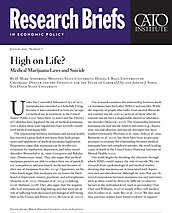Under the Controlled Substances Act of 1970, marijuana was classified as a Schedule I drug because it was considered to have no “accepted medical use in treatment in the United States” (Eddy, 2010). Since then, 23 states and the District of Columbia have legalized the use of medical marijuana; over a dozen more state legislatures have recently considered medical marijuana bills.
The relationship between marijuana and mental health has received a great deal of attention from both proponents and opponents of medical marijuana legalization. Proponents argue that marijuana can be an effective treatment for bipolarism, depression, and other mood disorders (Rosenthal et al., 1996; Grinspoon and Bakalar, 1997; Zimmerman, 1999). They also argue that medical marijuana patients are able to reduce their use of painkillers, tranquilizers, and psychiatric medicines because of their use of marijuana (Lucido, 2004). Opponents, on the other hand, argue that marijuana use increases the likelihood of depression, anxiety, psychosis, and schizophrenia (Zammit et al., 2002; Henquet et al., 2004; Goldberg, 2006; Shulman, 2008). They also argue that the negative effects of marijuana are long-lasting and that users are at risk of suffering from decreased psychological well-being later in life (Green and Ritter, 2000; McGee et al., 2000).
Our research examines the relationship between medical marijuana laws (hereafter MMLs) and suicides. While the majority of people who suffer from mental illness do not commit suicide, over 90 percent of those who do commit suicide have a diagnosable mental or substanceuse disorder (Moscicki, 2001). The relationship between marijuana use and suicide-related outcomes (e.g., depression, suicidal ideation, and suicide attempts) has been studied extensively (Petronis et al., 1990; Felts et al., 1992; Borowsky et al., 2001), but there have been no previous attempts to estimate the relationship between medical marijuana laws and completed suicides, the tenth leading cause of death in the United States (National Institute of Mental Health, 2010).
Our study begins by detailing the channels through which MMLs could impact the risk of suicide. We cite research from epidemiological and medical studies showing that marijuana use is associated with depression and suicidal ideation, although we note that any observed association between marijuana use and outcomes such as these could be driven by difficult-to-observe factors at the individual level, such as personality (Van Ours and Williams, 2011) or simply reflect self-medication (Gruber et al., 1996; Rey et al., 2002). We also note that previous studies have found evidence to support the hypothesis that marijuana and alcohol are substitutes (Chaloupka and Laixuthai, 1997; Saffer and Chaloupka, 1999; DiNardo and Lemieux, 2001; Anderson et al., 2013; Crost and Guerrero, 2011), and we cite research linking alcohol policies and suicides (Birckmayer and Hemenway, 1990; Jones et al., 1992; Markowitz et al., 2003; Carpenter, 2004; Carpenter and Dobkin, 2009).
Our empirical analysis draws on data from the Centers for Disease Control from 1990 through 2007 to examine the relationship between legalizing medical marijuana and suicide rates. This empirical approach can be thought of as exploiting a “natural experiment” unrelated to comorbidities or personality. Our results suggest that the passage of a MML is associated with an almost 5 percent reduction in the total suicide rate.
When we examine the relationship between legalization and suicides by gender and age, we find evidence that MMLs are associated with decreased suicides among 20- through 29-year-old males and among 30- through 39-year-old males. This result is consistent with registry data from Arizona, Colorado, and Montana showing that most medical marijuana patients are male, and that roughly half are under the age of 40 (Anderson et al., 2013, p. 360). Estimates of the relationship between legalization and suicides among females are less precise and sensitive to functional form.
We conclude that the legalization of medical marijuana leads to fewer suicides among young adult males. This result is consistent with the oft-voiced, but controversial, claim that marijuana can be used to cope with depression and anxiety caused by stressful life events. However, the result may, at least in part, be attributable to the reduction in alcohol consumption among young adults that appears to accompany the legalization of medical marijuana (Anderson et al., 2013).
Our study is relevant to the ongoing debate surrounding marijuana legalization for medical or recreational purposes. Opponents of these policy changes contend that any increase in marijuana use is undesirable. Yet our research suggests the public-health benefits of legalization may outweigh the costs.
NOTE
This Research Brief is based on D. Mark Anderson, Daniel I. Rees, and Joseph J. Sabia, “Medical Marijuana Laws and Suicides by Gender and Age,” American Journal of Public Health 104, no. 12 (December 2014): 2369–76, http://ajph.aphapublications.org/doi/abs/10.2105/AJPH.2013.301612. All works cited are provided there.
An earlier working version of the paper is available at: http://www.iza.org/en/webcontent/publications/papers/viewAbstract?dp_id….
